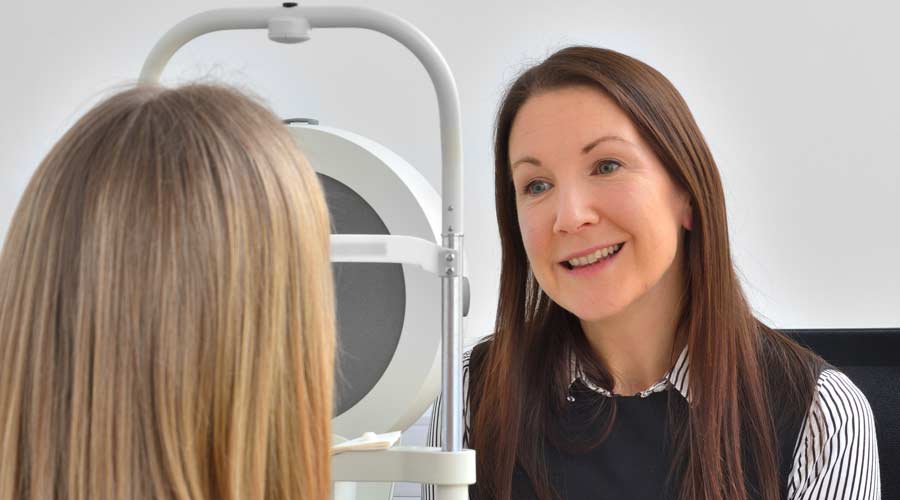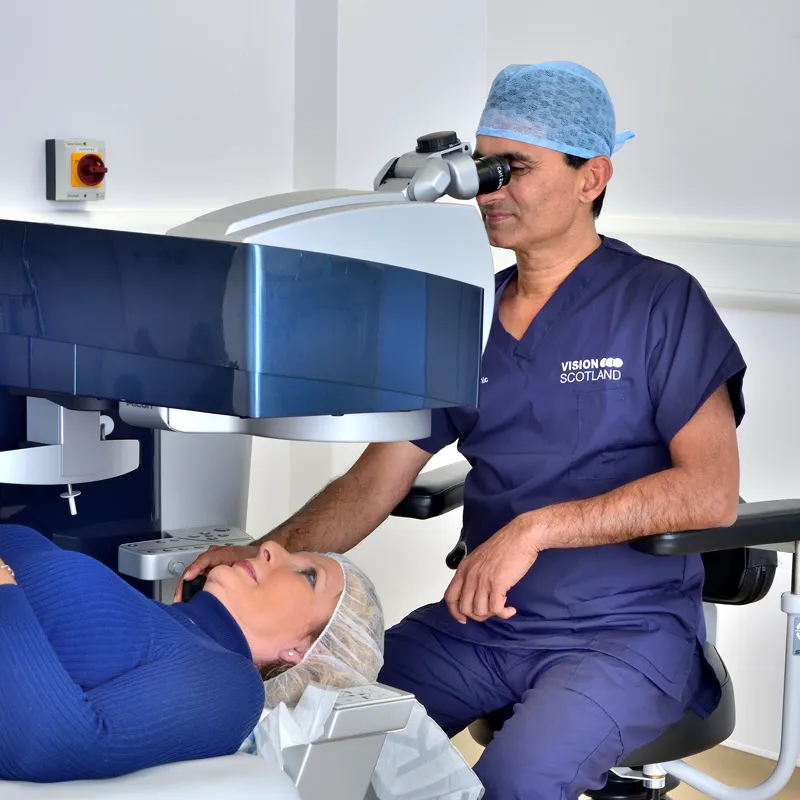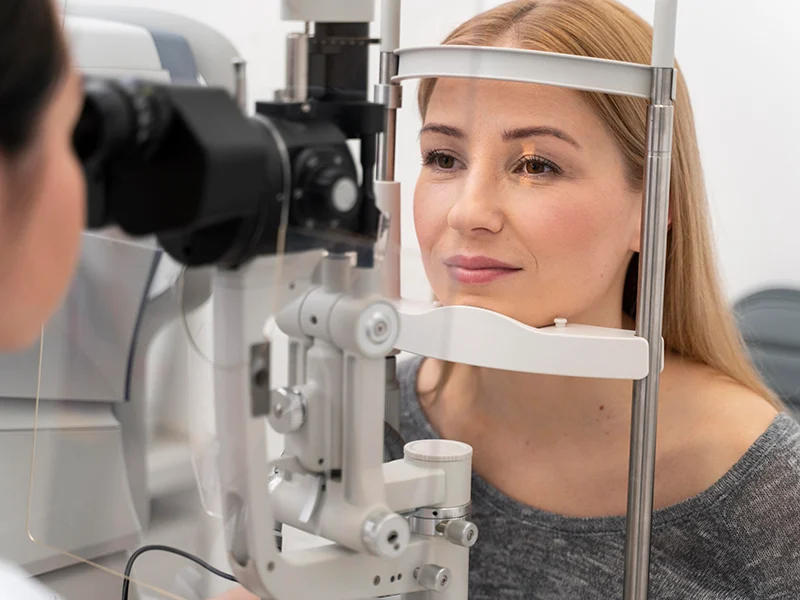Cataract: What are they? How are they treated? Who gets them?
A cataract develops when the normally transparent crystalline lens, found inside our eyes, becomes cloudy. This can make it feel like you are looking through a fogged-up or frosty window. It can become more difficult to read, drive a vehicle (especially at night), or see the expressions on friends’ faces if your vision is cloudy.
Most cataracts are slow-growing and can take up to several years to affect your vision. However, in some cases they can reduce the vision quite rapidly.
In the first instance, you may be able to improve your vision with stronger lighting and updated glasses. But if your vision can no longer be improved by these means, then cataract surgery may be necessary.
You may experience some of these symptoms with cataract:
- Cloudy or blurred vision
- More difficulty seeing at night
- Sensitivity to light/glare
- Brighter lighting is needed for reading and other activities
- Seeing “haloes” around lights
- Frequent changes in prescriptions for glasses/contact lenses
- Colour may look washed-out
- You may have double vision in one eye
If the cloudy area is small or not in your line of sight then you may not be aware of it. However, as it grows it can lead to more noticeable symptoms.
If you notice changes in your vision, make an appointment with an optometrist (optician) to have an eye test. If you notice any sudden changes such as double vision, flashes of lights, eye pain, or headaches then try see your optometrist immediately.
Causes
The most common cause of cataract is normal ageing of the natural lens. The lens’ proteins and fibres begin to degrade, thereby reducing the transparency of the lens and resulting in blurred or cloudy vision. Your risk of developing cataracts can be increased by some inherited genetic conditions which may also cause other health problems, as well as ocular injury, previous eye surgery, or medical conditions like diabetes. Cataracts can also develop from long-term use of steroid medication.
How does a cataract form?
The crystalline lens is located behind your iris (coloured part of the eye). When light enters your eye it passes through the lens to produce sharp images on the retina (the light-sensitive membrane inside the eye that functions in the same way as a film camera). As you age your lens becomes less flexible, less transparent, and thicker. Proteins and fibres in the lens start to break down, clump together and cause cloudy areas to develop. As the clouding gets denser it blocks light from reaching your retina, thus reducing your vision. Although cataracts usually develop in both eyes around the same time, they can occur in just one eye. One eye might have a cataract that is more advanced than the other, which can cause a difference between the vision in both eyes.
Cataract types include:
Nuclear: cataract affecting the centre of the lens.
Nuclear cataracts can cause you to become more short-sighted (myopic) or temporarily improve your reading vision. But as the lens becomes more yellow over time it further clouds your vision and can make it more difficult to distinguish between different colours.
Cortical: cataract affecting the edges of the lens.
It appears as whitish, wedge-shaped opacities along the lens cortex’s outer edge. These streaks gradually spread to the centre of the lens (sometimes resembling the spokes of a bicycle) and obstruct light from passing through the lens.
Posterior subcapsular: cataracts that affect the back of the lens.
These usually begin as a small, opaque area which tend to form near the centre of the lens (i.e in your line of sight). These types of cataract can cause blurred vision and halos at night, and often progress more quickly than others. Congenital: cataracts which are present from birth. Sometimes they develop during childhood. They can be genetic, or resulting from intrauterine infections/ trauma. These cataracts may not be symptomatic, but need to be removed as early as possible if they are interfering with a child’s vision.
Risk factors
These are some factors that can increase your chances of developing cataracts:
- Ageing
- Diabetes
- Excessive UV exposure
- Smoking
- Obesity
- High blood pressure
- Pre-existing eye injury or inflammation
- Previous eye surgery
- Long-term use of corticosteroids
Prevention
There are no studies that have shown how to prevent cataracts from developing or how to slow down their progression. However, there are several lifestyle factors that can help:
- Regular eye tests are important to detect early signs of eye problems such as cataracts. In Scotland this should be every 2 years from age 18-60, then annually from 60 onwards.
- Eat a varied diet, including plenty of fruits and vegetables (especially dark, leafy greens). Many antioxidants are found in fruits and vegetables, which can help keep your eyes healthy.
- Wear sunglasses outdoors. The sun’s ultraviolet rays can contribute to cataract formation.
When should you consider cataract surgery?
When your cataracts are affecting your quality of life or preventing you from performing normal daily activities such as driving or reading at night, then most eye care professionals would recommend cataract surgery.
Most people don’t need to have cataracts removed immediately as they don’t usually cause any harm to the eyes. However, the general consensus is that it is safer to remove them earlier as less energy is required to break down the cataract during surgery, and there is less risk of complications during surgery compared with removing a very dense cataract.
Discuss the pros and cons of cataract surgery with your optometrist. They may recommend regular follow-up visits to check if your cataracts have progressed.
What happens during cataract surgery?
Cataract surgery involves removing the cloudy lens and replacing it with a clear artificial lens. These intraocular implants are positioned in the same spot as your natural lens, and it becomes a permanent component of your eye.
In most cases one cataract is removed at a time, with the other one being removed (if necessary) a week or two later. Surgery itself takes about 20 minutes but you would be in the hospital for about 3 hours before going home. It is usually done under local anaesthetic (using eye drops to numb the eye), and is a relatively painless procedure.
Although cataract surgery is generally safe, there are risks of which you need to be aware. These include infection within the eye, bleeding inside the eye during surgery and retinal detachment. However, the risk of any of these happening is very low, especially in experienced hands.
If you have any questions regarding cataract surgery, please don’t hesitate to get in touch with one of our wonderful customer care team.
Written by: Optometrist Catriona Kennedy




